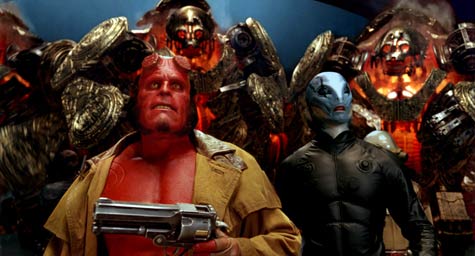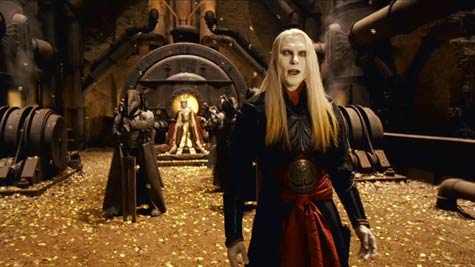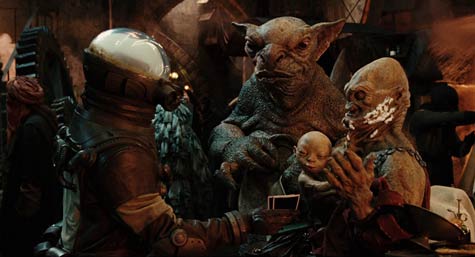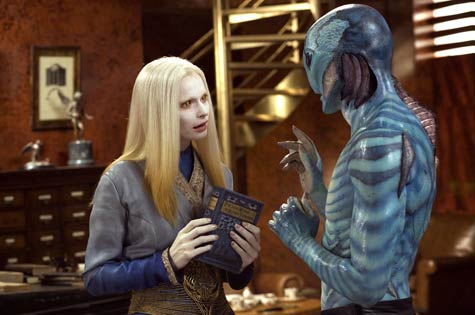
With three technical Oscars for Pan’s Labyrinth under his belt, Guillermo del Toro returned to Hollywood with the clout necessary to finally have full creative control on a project. (It’s harder to argue with a filmmaker when he’s got an Academy Award in the hand not holding the camera.)
Eager to return to one of his favorite fictional worlds, del Toro had been working on the script for Hellboy II: The Golden Army even as he was filming Pan’s Labyrinth. Unlike the first film, however, there wouldn’t be high-handed demands from producers or the studio—this time, del Toro would not compromise on his vision. Actor Doug Jones would be the face and voice of Abe Sapien; the budget would be bigger; the sets would be more elaborate.
Picking up a few months after the events of the first film, The Golden Army opens with a fairy tale that is more than a mere bedtime story. Hundreds of years ago, mankind was at war with the elven King Balor and the magical world he ruled. The titular and indestructible army was created by goblins in an attempt to stop humanity from polluting and destroying the earth. Eventually a truce was reached, the war ended, and Balor divided the crown that controlled the Golden Army into three pieces: two to remain with the elves, one to go with the humans.

In the present, the exiled Prince Nuada (Luke Goss, last seen as vampire Jared Nomak in Blade II)—son of Balor—returns with every intention of rekindling the war and awakening the Army. Determined to regain the pieces of the crown, he openly attacks a human auction and challenges his father at the elven court. But his immediate victory is thwarted when his twin sister Princess Nuala flees with the final crown piece.
Meanwhile, back at the B.P.R.D., Hellboy (Ron Perlman) and Liz (Selma Blair) are experiencing a few bumps in their relationship. Big Red is determined to take the organization public, tired of hiding from the rest of the world. His risk-taking antics drive Manning, the head of the B.P.R.D., to bring a new agent onto the team: the ectoplasmic Dr. Johann Strauss (Seth McFarlane, famous for Family Guy). While Abe and Strauss hit it off immediately, both being very intellectual, Hellboy takes an instant dislike to him—due in large part to the fact that Strauss is German, and Hellboy has plenty of reasons to hate Germans…

When the agents cross paths with Princess Nuala in the troll market hidden beneath Brooklyn Bridge, not only does Abe feel the first stirrings of love, they also attract the attention of the vengeful Nuada.
Many of del Toro’s villains fall under the same category: the fallen prince. Jacinto in The Devil’s Backbone is often referred to as a “lost prince” while Vidal of Pan’s Labyrinth is a brutal leader trapped in the shadow of his father. Like Nomak in Blade II, Nuada is a literal prince who is certainly cruel, vicious, and hard—but not entirely unsympathetic. Of all of del Toro’s baddies, he’s definitely the least evil. His motivations are understandable and even noble: he only wants to save the earth from the destructive plague of humanity. Is it right that mankind should have full control and power at the cost of the natural and magical worlds? Nuada argues that his people came first, that they have always had the planet’s best interests at heart, and from that perspective we humans truly are the monsters.
It’s one of the core conflicts in the story: magic versus mundane, “normal” versus monstrous. Hellboy himself is torn between both sides, wanting so desperately to walk down the street and be accepted by the Average Joe but forever treated as a freak at best, a dangerous threat at worst. Should he fight and kill these beautiful magical creatures on behalf of people who will only jeer and throw stones at him afterwards?
Hellboy II is hardly a dark or angsty movie, though. There are plenty of fun character moments; everyone gets a chance to shine, especially Abe Sapien. With his love story subplot, he gets to do a bit more than simply float around in giant tanks. And actor Doug Jones—one of my personal favorites—has even more to do onscreen in the guise of two other characters: the Chamberlain and the memorable Angel of Death.

While the first film was fun and its world-building was interesting, this sequel turns it all the way up to eleven. The elven court, Bethmoora, and the troll market are especially exciting, multi-layered sets that require multiple viewings to appreciate all of the detail and background activity. Prosthetics and physical effects continue to add a solid texture of reality to even the most outlandish sequences. And the stylization of the characters—from Nuada and Nuala’s cracked alabaster skin to Strauss’ steampunkish containment suit—are pure del Toro.
His fingerprints are everywhere; I’d even go so far as to say that Hellboy II is the most del Toro-ian film in his oeuvre, full of symbolism, dark beauty, tentacled creatures, clockwork, eyes where they shouldn’t be and missing from where they should, commentaries on religion and nature and family, and a bevy of heroes that will forever be outsiders looking in.
I’ll readily admit that there are plenty of plot holes and silly moments in Hellboy II; it’s certainly not as powerful or as well-constructed as his Spanish-language outings. But I also argue that those are minor flaws in an otherwise delightful film—the characters, visuals, and action sequences more than make up for some heavy-handed writing or obvious revelations. If you enjoyed the first film, you’ll enjoy the sequel even more.
And more than anything, the Hellboy films are fun. Del Toro knows fun, and would much rather make an enjoyable adventure than a serious drama. I, for one, am grateful for that. Dramas are a dime a dozen in my book—but an entertaining fantasy with great production values? Those don’t come along nearly as often as they should.
Angie Barry wrote her thesis on the socio-political commentary in zombie films. Meeting George Romero is high on her bucket list, and she has spent hours putting together her zombie apocalypse survival plan. She also writes horror and fantasy in her spare time, and watches far too much Doctor Who. You can find her at Livejournal.com under the handle “zombres.”
Read all posts by Angie Barry at Criminal Element.
